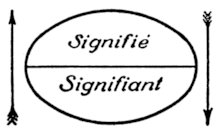Signified and signifier
Signified and signifier (French: signifié and signifiant) is a concept, most commonly related to semiotics, that can be described as "the study of signs and symbols and their use or interpretation."[1] Swiss linguist Ferdinand de Saussure, one of the two founders of semiotics, introduced these terms as the two main planes of a sign: signified pertains to the "plane of content," while signifier is the "plane of expression."[2]

Concept of signs
The concept of signs has been around for a long time, having been studied by many classic philosophers such as Plato, Aristotle, Augustine, William of Ockham, and Francis Bacon, among others.[3] The term semiotics derives from the Greek root seme, as in semeiotikos (an 'interpreter of signs').[4]:4 It was not until the early part of the 20th century, however, that Saussure and American philosopher Charles Sanders Peirce brought the term into awareness.[5]
While both Saussure and Peirce contributed greatly to the concept of signs, it is important to note that each differed in their approach to the study. It was Saussure who created the terms signifier and signified in order to break down what a sign was. He diverged from the previous studies on language as he focused on the present in relation the act of communication, rather than the history and development of words and language over time.[5]
Succeeding these founders were numerous philosophers and linguists who defined themselves as semioticians. These semioticians have each brought their own concerns to the study of signs. Umberto Eco (1976), a distinguished Italian semiotician, came to the conclusion that "if signs can be used to tell the truth, they can also be used to lie."[4]:14 Postmodernist social theorist Jean Baudrillard spoke of hyperreality, referring to a copy becoming more real than reality.[6] In other words, how the signified becomes more important than the signifier. French semiotician Roland Barthes used signs to explain the concept of connotation—cultural meanings attached to words—and denotation—literal or explicit meanings of words.[4] Without Saussure's breakdown of signs into signified and signifier, however, these semioticians would not have had anything to base their concepts on.
Relation between signifier and signified
Saussure, in his 1916 Course in General Linguistics, divides the sign into two distinct components: the signifier ('sound-image') and the signified ('concept').[4]:2 For Saussure, the signified and signifier are purely psychological: they are form rather than substance.[7]:22
Today, following Louis Hjelmslev, the signifier is interpreted as the material form, i.e. something which can be seen, heard, touched, smelled or tasted; and the signified as the mental concept.[8]:14 In other words, "contemporary commentators tend to describe the signifier as the form that the sign takes and the signified as the concept to which it refers."[9] The relationship between the signifier and signified is an arbitrary relationship: "there is no logical connection" between them.[4]:9 This differs from a symbol, which is "never wholly arbitrary."[4]:9 The idea that both the signifier and the signified are inseparable is explained by Saussure's diagram, which shows how both components coincide to create the sign.
In order to understand how the signifier and signified relate to each other, one must be able to interpret signs. "The only reason that the signifier does entail the signified is because there is a conventional relationship at play."[10]:4 That is, a sign can only be understood when the relationship between the two components that make up the sign are agreed upon. Saussure argued that the meaning of a sign "depends on its relation to other words within the system;" for example, to understand an individual word such as "tree," one must also understand the word "bush" and how the two relate to each other.[11]
It is this difference from other signs that allows the possibility of a speech community.[10]:4 However, we need to remember that signifiers and their significance change all the time, becoming "dated." It is in this way that we are all "practicing semioticians who pay a great deal of attention to signs…even though we may never have heard them before."[4]:10 Moreover, while words are the most familiar form signs take, they stand for many things within life, such as advertisement, objects, body language, music, and so on. Therefore, the use of signs, and the two components that make up a sign, can be and are—whether consciously or not—applied to everyday life.
References
- "definition of semiotics". Oxforddictionaries.com. Retrieved 18 March 2015.
- Meen, Teen-Hang; Prior, Stephen; Lam, Artde (2015). Innovation in Design, Communication and Engineering: Proceedings of the 2014 3rd International Conference on Innovation, Communication and Engineering (ICICE 2014), Guiyang, Guizhou, P.R. China, October 17-22, 2014. Boca, Raton, FL: CRC Press. p. 454. ISBN 9781138027527.
- Kalelioğlu, Murat (2018). A Literary Semiotics Approach to the Semantic Universe of George Orwell's Nineteen Eighty-Four. Newcastle upon Tyne: Cambridge Scholars Publishing. p. 11. ISBN 1527520188.
- Berger, Arthur Asa. 2012. Media Analysis Techniques. Beverly Hills: Sage Publications.
- Davis, Meredith; Hunt, Jamer (2017). Visual Communication Design: An Introduction to Design Concepts in Everyday Experience. London: Bloomsbury Publishing. p. 135. ISBN 9781474221573.
- Berger, Arthur Asa (2005). Media Analysis Techniques, Third Edition. Thousand Oaks, CA: SAGE. p. 14. ISBN 1412906830.
- Berger, Arthur Asa. 2013. "Semiotics and Society." Soc 51(1):22–26.
- Chandler, Daniel. 2017. Semiotics: The Basics. New York: Routledge.
- Chandler, 2002, p.18.
- Cobley, Paul, and Litza Jansz. 1997. Introducing Semiotics, Maryland: National Bookworm Inc.
- Chandler, 2002, p.18.
Sources
- Ferdinand de Saussure (1959). Course in General Linguistics. New York: McGraw-Hill.